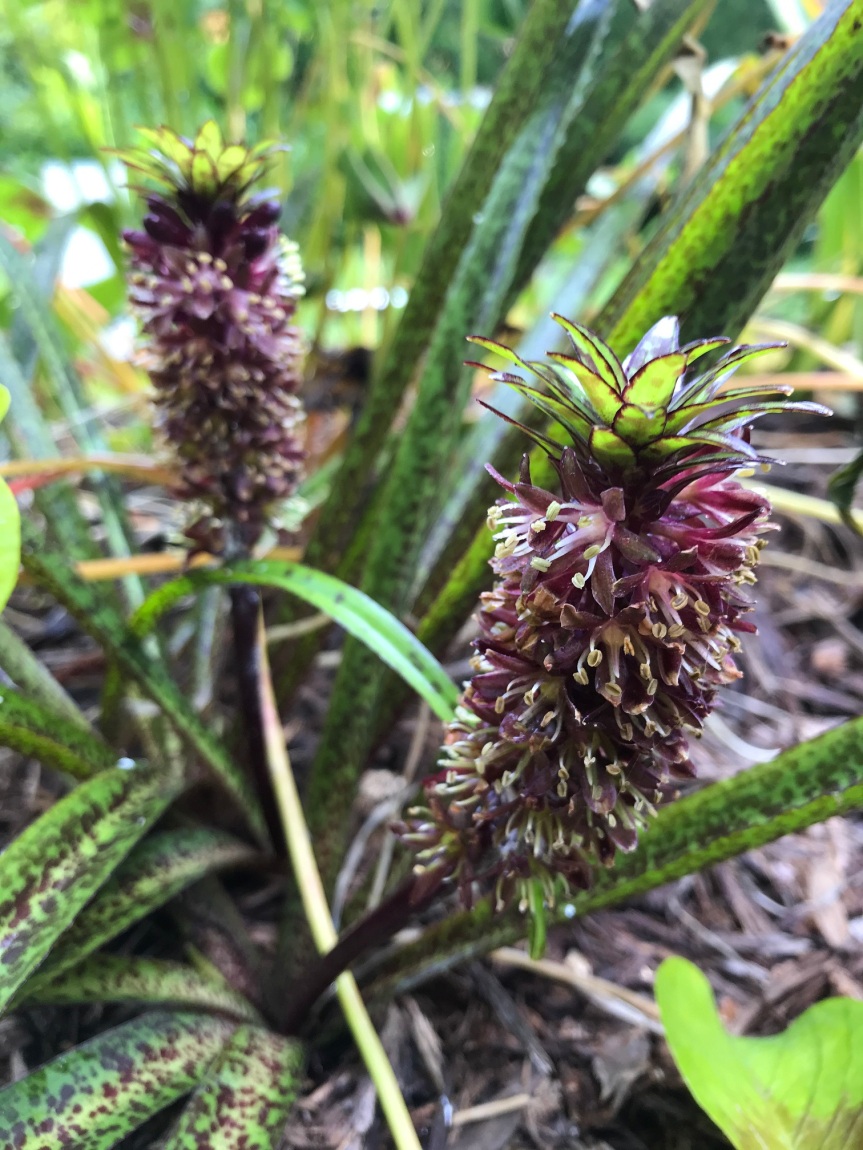This week’s Six on Saturday includes a couple of native species, an unusual vegetable, a cute little bulb from South Africa, a classic Victorian hybrid, and a greenhouse orchid that is really very nasty.
1. Bulbophyllum phalaenopsis

This is not an orchid for growing on your windowsill or decorating your table at a dinner party. If you think that the flowers of Bulbophyllum phalaenopsis look a bit like rotting meat covered with yellowish maggots, I can assure you that they smell exactly the way they look. B. phalaenopsis is pollinated by flies looking for a place to lay their eggs, but if the fly is fooled by the ersatz carrion, the maggots will starve.
2. Canna ‘Ehemannii’

C. ‘Ehemannii’ is an old Victorian hybrid of C. iridiflora crossed with (probably) C. indica, and it has inherited its drooping inflorescence from C. iridiflora. Several modern C. iridiflora hybrids, including Canna ‘Orange Crush’ failed to survive the winter in my garden, but this plant, which I received from Bittster of Sorta Like Suburbia fame, has survived two winters so far. I’m glad, because I adore the intense magenta color that is so very different than any other canna in my garden.
3. Sabatia species

This pretty little native wildflower often shows up at the edge of my lawn (i.e. the patch of weeds and moss that survive being mowed). I think it is Sabatia angularis (rosepink), a widespread annual, but I am not certain.
4. Eucomis vandermerwei

E. vandermerwei, from South Africa, is one of the smallest of the pineapple lilies. Along with E. zambesiaca, it seems to be resistant to the wilting exhibited by many other Eucomis in hot sunlight, making it a good choice for a North Carolina garden.
5. Allium cernuum (nodding onion)

The nodding onion has a very wide native range, spanning the United States from Atlantic to Pacific. In North Carolina its distribution is spotty, and although it has been reported from this county, my plants were purchased from the North Carolina Botanical Garden. Leaves and flowers are edible but strong tasting. I prefer to eat garlic chives.
6. Melothria scabra (Mexican sour gherkin, cucamelon)

First fruit from from a plant that we bought on a whim from a veggie seedling rack this spring. The little vine looks almost identical to the weedy Melothria pendula but its fruit are better tasting. I could probably have left these to get a bit bigger, but then I’d risk losing them to the tree rats.
The Propagator is the host of Six on Saturday. Head over there to see his Six and find links to the blogs of other participants.

It’s often said that the photos showing the color red don’t do it justice but yours with this canna is gorgeous.
The cucamelons should be eaten small and crunchy. I love them ! Try as pickles in vinegar it’s delicious too.
LikeLiked by 1 person
Unusual and interesting
LikeLiked by 1 person
I can not figure cannas out. They all do well here, but I was surprised by how well some do in colder climates too. I noticed some growing wild without shelter in winter in Oklahoma.
LikeLiked by 1 person
Yeah, they’re unpredictable. About 2/3 seem to be fine in our climate, but the remainder rot during the winter. Some clones I have tried more than once, so I’m fairly sure it wasn’t a fluke.
LikeLiked by 1 person
Do you find that the fancy garden varieties (hybrids) are the weaker sorts?
LikeLike
It’s hard to say, because I don’t know the parentage of most of my cannas. There may be something to that idea, though. The plant that is the most vigorous and emerges earliest is ‘Flaming Kabobs’ which may be a species or primary hybrid.
LikeLiked by 1 person
Well, it does happen to ‘look’ simpler, as if less bred.
LikeLike
The Canna looks wonderful. Sour Mexican Gherkins sounds wonderful.
LikeLiked by 1 person
Your Eucomis is the winner for me. Beautiful
LikeLiked by 1 person
Hah! Glad to see the canna is doing well, if I remember correctly the tuber was nearly dead when I sent it, so you have done some magic there. Sadly mine did not make it, but the flying dragons you sent are alive and well and if they can just get past the scars of a late spring freeze, then they should be taking off and making their own scars on me!
LikeLiked by 1 person